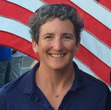Carol Newman Cronin's Blog, page 2
July 17, 2025
Meant to Be: Cheering on Hound from 35,000 Feet
A few weeks ago, I flew to England to help the Hound team celebrate her third west to east Transatlantic crossing. Five hours into the flight, I woke to find dawn breaking outside the airplane window—and immediately checked the race tracker: we were directly over the boat! Of course all I could actually see below was empty blue, but I still got chills—which prompted a text to Nick, the boat’s onboard reporter: “I’m flying over you right now!” He immediately texted back: “Watch change! Everyone says hi” with a waving emoji. For the next hour I continued to stare out the window, visualizing a familiar vessel crossing that vast ocean 35,000 feet below—which required no imagination at all, thanks to Nick’s fantastic drone shots.
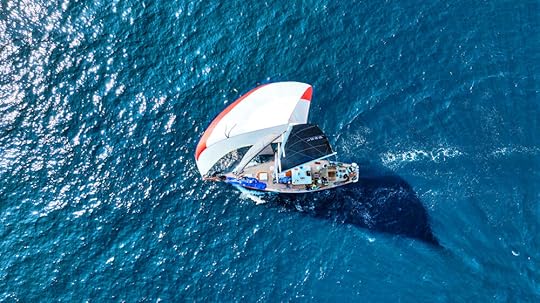
The race finished in Cowes, and when I arrived there the next day I was honored with an invitation out onto the platform at the Royal Yacht Squadron—home of the first America’s Cup race—to watch other boats completing the race. After 3000 miles, three crossed the historic line within minutes of each other—probably the closest finish since the race began in 1866. As each cannon fired in welcome, I knew I was exactly where I was meant to be—and even better prepared to greet my favorite team whenever they finished.
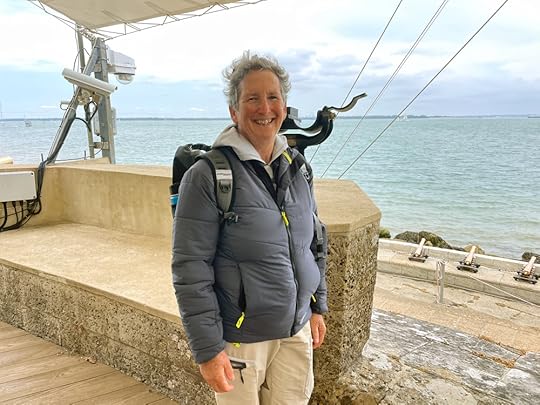
Unfortunately a pre-dawn arrival meant no cannon blast for Hound, but her friends and family cheered as loudly as we could from our RIB before escorting them into the dock. After two weeks together you’d think those 13 tired sailors would have been eager to escape each other’s company; instead, after a few hours of much-needed sleep, we found ourselves all clustered together around an outdoor picnic table, taking up a space only a little bigger than the boat’s main cabin. They had crossed an ocean together, and they weren’t yet ready to return to their normal, separate, lives. Again, exactly where I was meant to be.
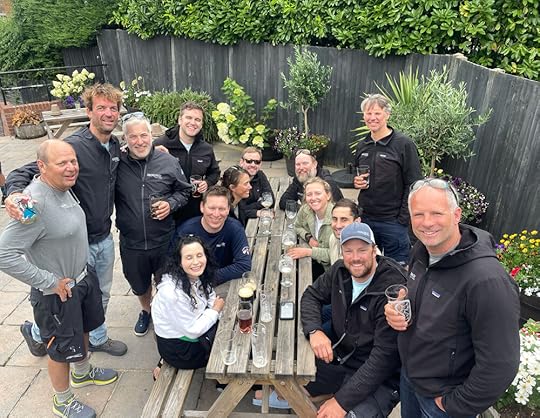
Hound’s next adventure will be her very first Fastnet Race—on that same famous line, off the Royal Yacht Squadron. Lofty new goals aren’t usually expected of middle-aged matrons, but I’m sure she will do both her crew and her many devoted fans proud. And while I’m sad I won’t be at the finish line to greet them, I will be cheering them on from our annual Maine escape. Bittersweet perhaps, but also exactly where I’m meant to be . . . and, thanks to technology and Nick’s fantastic photos, requiring no more imagination than that airplane-window perspective of 35,000 feet.
Got a moment that stuck out for you as “exactly where I should be”? Share it in the comments below, or send me an email. I read every single one, with gratitude. See you next Thursday!
The post Meant to Be: Cheering on Hound from 35,000 Feet appeared first on Carol Newman Cronin.
July 10, 2025
Steve Clark Just Can’t Sit Still
More months ago than I prefer to admit, I received a rare request for a profile from Andrew Hurst at Seahorse Magazine:
“I know we are behind publishing your material, but one day would you consider a profile of Steve Clark. Aside from being a hero, a distant friend and a sailing genius he has changed the sport in his own occasionally!! humble way—and raised a great son Dave in his own innovative image.”
 Photo: Joe Berkeley
Photo: Joe BerkeleyIt took me over a year to follow up on this suggestion, but once I interviewed Steve (on a shivery and short afternoon last December), I couldn’t wait to connect his stories about a life at the bleeding edge of the marine industry into something resembling a profile. I soon realized there were too many stories for one issue, so I suggested it be divided over two (like they did for Bill Mattison and Peter Harken). Andrew quickly agreed, adding: “Only two parts . . . you can’t have spoken for long.” Clearly he understood how many words Steve could pack into a few hours of conversation.
When I saw Joe Berkeley’s distinctive portrait of Steve on the cover of the June 2025 issue, I eagerly paged through to find a surprise: they’d somehow shoe-horned all of my words onto six pages. And since there’s much more inside that issue than what they are now calling my “exhausting but fascinating visit to the rocket-man in the woods,” I encourage you to subscribe.
Got a suggestion for a future profile, or a memory of Steve? Share it in the comments below, or send me an email. I read every single one, with gratitude. Thanks for being here!
Read Steve Clark
Previous Seahorse ProfilesPaul Callahan: Maximizing His Unique Potential
Giving Paul Bieker Some Seahorse Love
Betsy Alison: Using All the Tools
Jerry Kirby: All the Stories are True
Peter Harken: What an Amazing Guy
Buddy Melges: He Really Was a Wizard
Toppa Talks: One Job, One (Big) Dream
Circus Minimus: The Rich Life of Bill Mattison
Mark Reynolds: Hard Chines and Unasked Questions
Dawn Riley: Setting the Standard
Clicks of Chance: Onne van der Wal
Just Say Yes: Stan and Sally Honey
Rod Davis: Why You Need His Wisdom in 2021
Rod Johnstone: An Amazing Legacy of Yacht Designs
A Final Conversation with Harry Anderson
Vince Brun Profile in Seahorse
The post Steve Clark Just Can’t Sit Still appeared first on Carol Newman Cronin.
July 3, 2025
The Rare Gift of 20,000 Hours
According to Malcolm Gladwell, we each need to practice something for at least 10,000 hours to achieve mastery. Though I would argue that quality matters as much as quantity, a quick and dirty estimate back in 2004 revealed a surprising “fact:” that’s about how much time I had put into sailboat racing on my way to the Olympics.
(Even after writing this post, I still haven’t bothered to add up all the hours since then.)

Kim Couranz has put in her own 10,000 hours racing sailboats, and a lot of that time has been in a Snipe with me. I’ve written before about the benefits of a long-term sailing partner, and a few weekends ago we put our 15 years of mutual muscle memory to use at the Snipe Colonial Cup in Annapolis. After one light-air hour of practice on Friday afternoon and getting blown out on Saturday, we sailed out Sunday morning for a four-race, one-day regatta—in one of the most difficult wind directions. The wacky 5-20 knot westerly never did settle onto a direction or strength for more than about 30 seconds.
Thanks to work and other distractions, our last Snipe regatta was back in February. Before racing, I grudgingly admitted to Kim (and myself) that it would probably take a race or two before I found my groove again.
I was right. We were already halfway through the regatta before I was steering well upwind; anticipating rather than reacting to puffs, lulls, and particularly odd waves. Downwind the mixed-up chop seemed too small and close together to be easily surfable, so we prioritized both keeping the bow from burying and staying upright. It wasn’t until after racing that I realized how many teams had capsized; I was far too focused on my own boathandling to look around. But as I gradually regained my feel, our speed improved; we posted our best result on the last race of the day.
Even if Kim and I have only averaged ten days of Snipe sailing each year since 2010 (and I bet it’s more), that’s almost 1000 hours—each—of building muscle memory. Out of 48 boats in the Colonial Cup fleet, I can only think of one other team that has logged more time together in a Snipe—and they’ve been married for 30 years, while we live 400 miles apart.
It’s a rare gift to share such a passion for this challenging corner of our sport with someone who encourages me to do my best—without judging when I don’t achieve that. I’m so grateful to Kim for her friendship, support, and willingness to continue sailing with me; I can’t imagine how long it would’ve taken for me to settle into such a difficult sailing day without all of those hours and miles of team familiarity.
Our next regatta is only a week away, and thanks to Monday night racing I will be a little less rusty by then. But I will still be relying heavily on the fantastic depth of our experience—especially since almost all of those hours we’ve accumulated together have been a boatload of fun.
Got a long-term sailing relationship to crow about? Share your thoughts in the comments below, or send me an email. Thanks for being here, and see you next Thursday!
The post The Rare Gift of 20,000 Hours appeared first on Carol Newman Cronin.
June 26, 2025
How Do We Shelve Our Favorite Books?
Thanks to a recent house project, I recently removed all of the books from our living room bookshelves—for the first time in 20-plus years. When I reshelved them a few weeks later, I found myself wondering if there was a better way to organize them all. (Don’t worry, I never considered “by color.”) I quickly realized that my seemingly haphazard approach still made sense, so other than some culling I returned them somewhere close to their original spot once more.
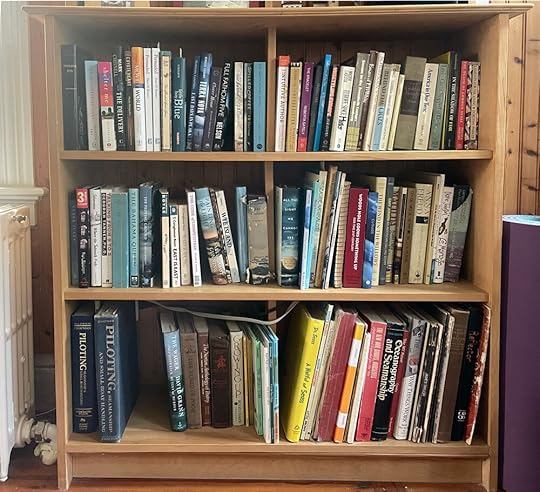 By size
By sizeIn many cases, there was actually no real choice; the bookshelf’s builder (me) created top shelves that aren’t tall or deep enough for anything other than small paperbacks. Books are no longer produced in that format, so to those top shelves returned the same mystery authors: Dick Francis, John le Carré, Ken Follett. Even my favorite detective fiction author, Elizabeth George, had to be relegated to a lower shelf.
By topicAt the opposite end of the “cozy” spectrum are several college textbooks. All of those that still seem worth saving came from one particular reading list, put together by the professor who inspired me to major in European History. (One is actually a novel, which might help explain that choice.)
Of course the dominant subject is boating; everything from kids’ stories to Piloting, Seamanship, and Small Boat Handling. Most sailors refer to that book only by its author’s last name, “Chapman’s;” thanks to the reshelving project, I discovered that we own two copies, now shelved side by side.
By memoryAnd then there are the books that have nothing to do with sailing or boats. I’m sure I wouldn’t have bothered holding onto (or even reading) Carol On Broadway by Helen Dore Boylston if not for the main character’s name. But just the sight of its faded red spine brings me right back to childhood, reading myself to sleep.
By authorI’ve saved the best for last: the growing collection of books by authors I’ve actually met—maybe even befriended and/or edited. Over the years, those tomes have outgrown their original section; I can’t think of a better way to show off the rich life of this author and reader.
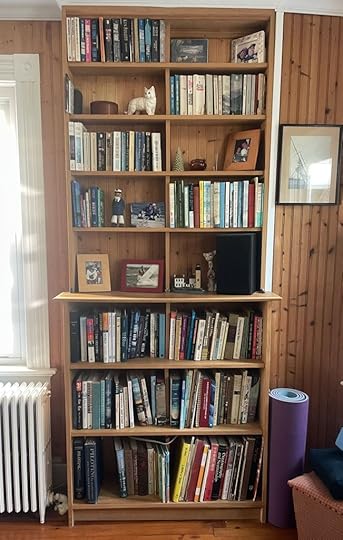 More please
More pleaseThanks to passing along a few old favorites, there’s now room for new additions (note that gap on the bottom shelf). Perhaps some of the books in my enormous TBR pile (currently occupying the entire bedside shelf upstairs) will earn their spot on these shelves? If so, I’ll try to fit them in where they make the most sense—haphazard though my “system” may seem to others. I might not sort books by color, but it’s an inspiring palette nonetheless.
How about you; how do you shelve your books—never mind decide which to keep? Share your thoughts in the comments below, or send me an email. I read every single one, with gratitude.
Thanks for reading, and see you next Thursday.
The post How Do We Shelve Our Favorite Books? appeared first on Carol Newman Cronin.
June 19, 2025
Hound Starts Her Third Transatlantic
Watching Hound start the 2025 Transatlantic Race yesterday, my mind wandered back to her first two ocean crossings from west to east. In 1991, she sailed all the way to what was then known as Leningrad, USSR. In 2004, she made landfalls in Ireland, Spain, and Portugal before returning to the Caribbean for the winter.
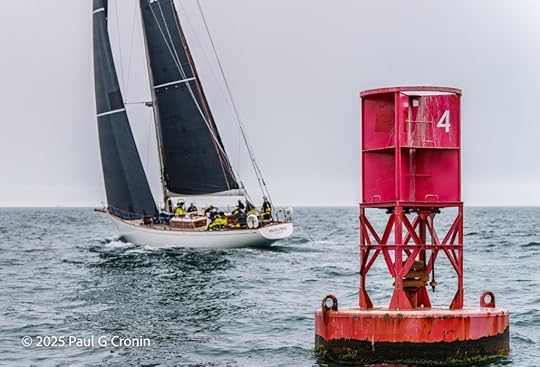
How would a US-flagged sailing vessel be received today in what’s now St. Petersburg, Russia? We’re not about to find out, so instead here are three quick stats to show what’s different about the boat and crew this time around:
1. She’s racing hard against 10 other boats
2. She has more than double the crew to feed
3. She can relay daily messages, and we are able to track her progress in (almost) real time
And then there are the aspects of ocean crossings that are refreshingly timeless: both boat and crew have to deal with whatever the ocean throws at them, relying only on each other. As the Transatlantic Race website puts it, “The west-to-east route tests sailors with the unpredictability of the North Atlantic, serving up everything from gales and fog to high-pressure systems and subtly shifting wind patterns.”
Hound may not be heading as far east as Russia, but she’s still making history (again) this time; I’m pretty sure she’s the only Aage Nielsen design ever to compete in The Transatlantic Race, which has been taking place since 1866.
Back in 2004, one of Hound’s crew said that he didn’t want that passage to end; “We just got into this wonderful groove of reading and sleeping and sailing. The closer we got to land, the less we wanted to get there.” I won’t be surprised if Hound’s 2025 team expresses similarly bittersweet feelings at the finish, even after weeks away from their busy lives.
Want to learn more? Follow @houndsailingteam or visit the Transatlantic Race website. And of course there will be lots more detail in The Heart of Hound!
The post Hound Starts Her Third Transatlantic appeared first on Carol Newman Cronin.
June 12, 2025
What Is There to Say Except: It’s June!
The birds are singing outside my office window. The harbor is calling. And the words and ideas just aren’t coming today.
You’re probably too busy yourself with boat or garden or book projects to read anything too in-depth, so this week I’m going to highlight some of my favorite posts from previous years—along with some of my favorite photos. Taken together, they make me realize how timeless the “launching” season is—even now that I no longer own a boat that needs varnishing.
 June: Pure Potential
June: Pure Potential“This is the time of year when boats are launched, summer plans are hatched, and the possibilities and energy levels seem limitless. In the garden, everything is electrified: annuals and perennials alike vie for best-dressed flower, no matter how much time went into their actual planting or how deep their roots actually go.”
 Diving into Summer, and Everything Else Too
Diving into Summer, and Everything Else Too“Each June, that first swim is always the hardest. Standing on the edge of dry, already anticipating wet, I savor the in-between; the about-to-be. My daily swim forces me across the edge of life’s comfort zone, again.”
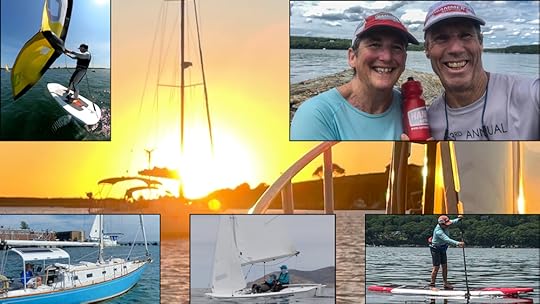 Where Books Meet Boats: No Such Thing as “Chore”
Where Books Meet Boats: No Such Thing as “Chore”“And on the many foggy writing mornings when I can’t really see where putting words on the page will eventually lead, the afternoon’s sailing might just be its own reward.”
 Happy 10th Anniversary, Blog
Happy 10th Anniversary, Blog“To celebrate a decade of blogging, I took a fresh stroll back through the archives to weed out 10 of my favorite posts. My takeaway? Specific topics have evolved, but the name is still a great match.”
 Debbie Ohi shared this inspirational graphic in 2017 and I’ve had it pinned above my desk ever since.Farewell June, My Favorite Month
Debbie Ohi shared this inspirational graphic in 2017 and I’ve had it pinned above my desk ever since.Farewell June, My Favorite Month“Every year, I beg the month of June to just slow down already—and it never listens. Couldn’t we somehow stretch out June until it’s more like an entire quarter?”
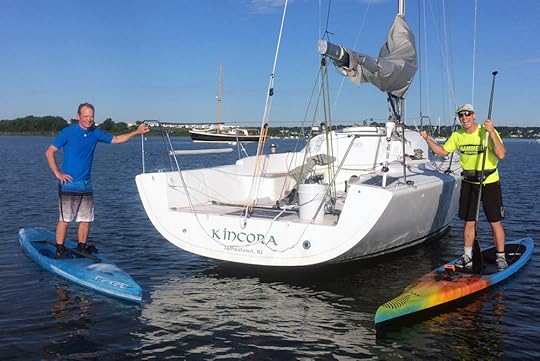
This blog celebrates its 16th anniversary this week, and June is rushing by even faster than I remember. I promise to be back with a fresh post next Thursday. Meanwhile, share your June thoughts in the comments below, or send me an email—unless you’re too busy enjoying this 2025 version of my favorite month of the year!
The post What Is There to Say Except: It’s June! appeared first on Carol Newman Cronin.
June 5, 2025
Like Sending a Favorite Kid off to College
Those of you who come here often will remember that, back in February, I put our most beautiful family member up for sale. After a few months of showing her off to “keel kickers,” I’m happy to report that Matsya will start her 88th season on western Long Island Sound.
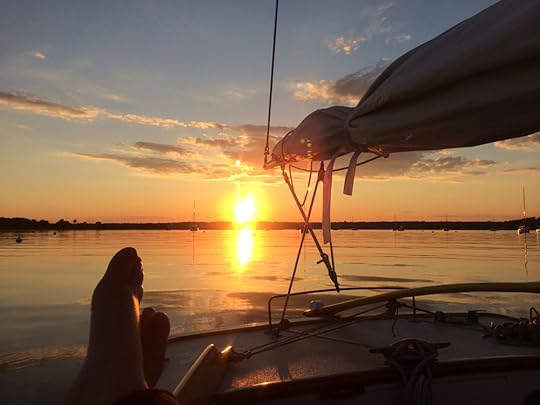
Writing up the listing, I privately compared the process to selling a child. Now that she’s found a good home, it feels more like sending a favorite kid off to college: definitely leaving behind an empty nest, but also the best thing for her. Though she’s in better shape than when I found her, as a wooden-boat-savvy friend put it, “You did well by the boat — now it’s someone else’s job.”
As I was digging through a folder of paperwork to see what needed to be passed on to that someone else, I found a vague note about her history. Hiding behind an obscure list of must-dos (designed to ensure a curse-free name change) was a forgotten family tree of previous owners. I can now add my name at number five on that list, which makes my stewardship (2007-2025) about average.
Matsya helped inspire my first (published) novel, so she won’t be forgotten. As I said in 2009, “there is no bad mood or stressful work day that can’t be cured by a leisurely sail up or down West Passage.” I will surely miss The Joy of Day Sailing (and occasional afternoon naps) that she provided, but now she deserves to share her unique combination of grace, perspective, and joy with a fresh harbor and owner. Like any parent, I was just a caretaker for 18 years, helping to ensure a life both long and leak-free.
Sail on, fair Matsya. And if you have a chance, let this empty-nester know what you choose for a major. Dare I suggest Nautical History?
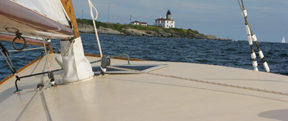
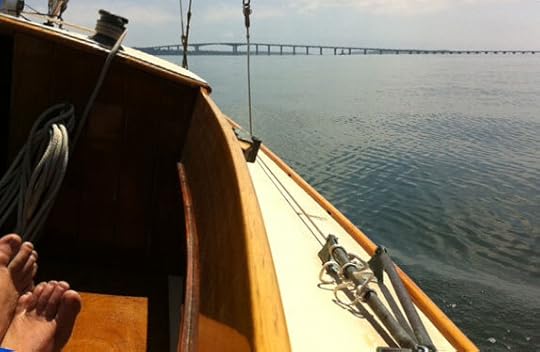
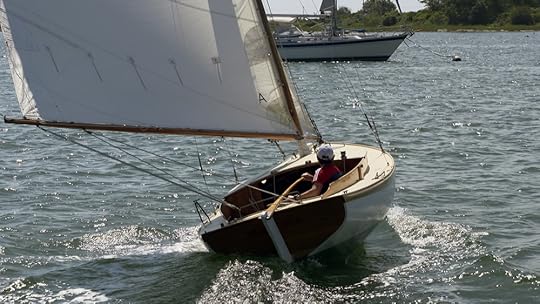

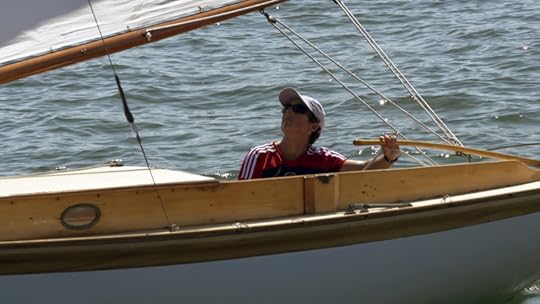
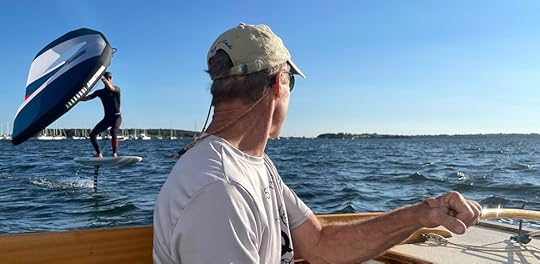
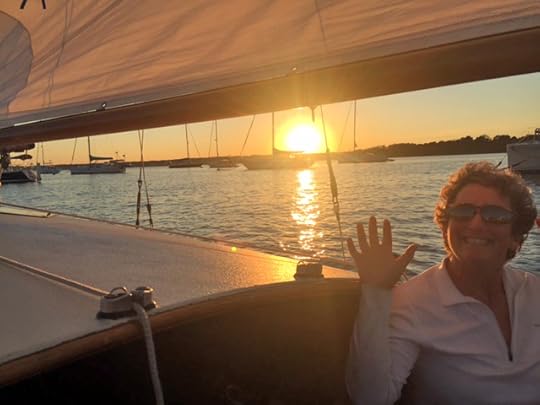
The post Like Sending a Favorite Kid off to College appeared first on Carol Newman Cronin.
May 29, 2025
Book Review: Little Great Island
Full disclosure: author Kate Woodworth is a friend. Her excellent 2018 feedback on Ferry to Cooperation Island led directly to my landing an agent, though first she sent the following confession:
“I am about fifteen pages into your book and am really enjoying it… I love your metaphors and think you do a marvelous job of introducing character and conflict in the opening.
“But before I continue I wanted to make sure that you remember that I have written a first draft of an island book . . . . I don’t want you to freak some day when you (hopefully) read my book and think: holy cow! I’ve been robbed!”
I’m so glad I replied, “Thank you, please keep reading.”

Since then, we’ve celebrated and commiserated our books’ many publishing ups and downs. Whenever we really needed a pick-me-up, we’d reminisce about our first shared adventure. Only a few hours after meeting at a 2018 Writers Conference, we went in search of some much-needed food to celebrate what would turn out to be two very short-lived agent-victories; the only option turned out to be dessert for dinner. And “it wasn’t just ANY dessert for dinner,” Kate reminded me recently. “It was BURDICK’S CHOCOLATE!”
Given both my appreciation of the author and the similarity between our two books, I was both excited and (again, full disclosure) a bit trepidatious when my pre-ordered copy of Little Great Island showed up. What if I hated it? I loved the cover, but . . . .
Fortunately, after devouring the story, I no longer have to worry about that. Instead I’m trying to curb my jealousy, because Little Great Island is in many ways the book I’ve always wanted to write. Set on an island in Penobscot Bay, Kate has created a tiny independent community that also somehow serves as a metaphor for the entire world. Through a very specific and optimistic lens, she shows us realistic approaches to development, climate change—and cults.
The island itself kicks off the story, giving us a bird’s eye view of both human and geological topography—and how one has affected the other. The touch is so light, I might not have identified the omniscient narrator without the chapter’s subtitle. Here’s the first paragraph:
It’s April on a Down East island—a waning-moon-shaped haven, an isle of spruce and granite and seagull—where a clutch of steadfast families pulls their living from the sea. Out on the water, a chain of lobster boats heads into the fog bank parked on the horizon, their wakes rippling in Vs behind them. In the yards and houses, cats stalk, smokers hack, and coffee brews. Morning sun glimmers on the bent grasses grown long in the slump-stoned cemetery, while in the kitchens the news is of wind speed and tide charts, of dock prices per pound of lobster, of fuel and tariffs and catch predictions, both dire and good.
We soon learn that those boats—and their people—are heading into a metaphorical fog as well, dragging the past and “we’ve always done it this way” along in their wake.
All of the characters make both good and bad decisions, but we understand why because the story is told by a whopping 10 of them. Each interacts differently with the island and its surrounding waters; the only commonality is the interconnectedness of all creatures, humans included.
I do have two tiny editorial quibbles. The first is the many missing small words (the hardest typo to catch), especially later in the book. The second is the lack of time-passing specifics; early on, it was hard to know whether an hour or a week had elapsed between chapters. I quickly got used to that, though; when the island finally told me it was August, I found myself wondering; why do I need to know the exact month? (Answer: because summer was coming to an end.)
Neither of these pesky details interfered with what felt like a visit to Maine—as a local. Which is why it’s not just friends who appreciate the book; since its April launch, Little Great Island has garnered many positive reviews. It’s also sparked Be the Butterfly, an invitation to readers to perform one small act to help mitigate climate change. Learn more on Kate’s website, and while you’re there check out her many book events this summer.
As I’ve said before, it’s extremely rare to enjoy both the author and the writing they produce. So here’s to Kate for being both a supportive friend and a jealousy-inducing author! I can’t wait for our next “dinner” together.
Got an island book to recommend? Share your thoughts in the comments below, or send me an email. Either way, thanks for stopping by! See you next week.
The post Book Review: Little Great Island appeared first on Carol Newman Cronin.
May 22, 2025
Repowering Katrina, and My Dad
Perhaps the best moment of any cruise on Katrina is when the engine is shut down, leaving behind the welcome ahhhh-quiet of wind-powered progress. Purists might consider motors on sailboats a contradiction. But without auxiliary power, there’s no way this 38-footer would’ve brought us to so many wonderful harbors over her 55 years.
And since her cruises often start in Woods Hole Passage, a reliable source of direct upwind progress is also an important safety item. Which is why, once Katrina began her long winter’s nap last year, my father decided to replace her almost 40-year-old engine. “I’m going to need a project this winter,” he said in November, shortly after ordering the new motor. Because, just as he’s done for all of Katrina’s upgrades, he planned to do the work himself.
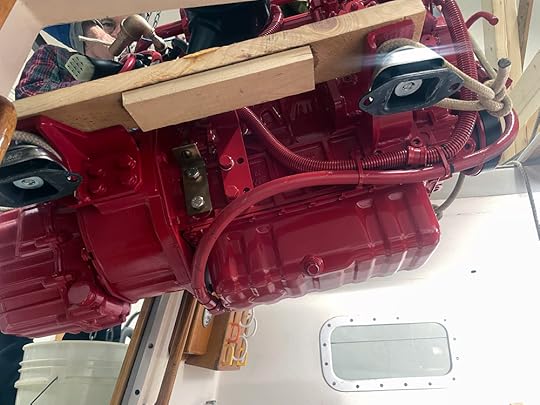
Sailboat auxiliaries have shrunk in size since the 1980s, so as soon as the old engine was pulled out Dad measured the mounts; yup, they’d have to be reconfigured. We all poured our unique skills into the challenge: while Paul helped Dad think through each next step, I jumped in with (occasionally useful) “facts” about the two previous engine installations (1970 and 1988). Some of those memories were even confirmed by Katrina herself as the archeological dig progressed.
The project dominated our conversations over Christmas, because the original engine beds were not quite level. It would’ve been easy to say “well, they’ve worked fine since 1970.” Instead Dad took the time and energy to build up the starboard side until it was the same height as the port one. He even made his self-imposed deadline; when my sister flew into town for his 90th birthday party, we celebrated with an all-sibling gathering to drop the new engine into place.

But that was just one (big) task on a still-lengthy list. The boat’s electrical panel had to be replaced to accomodate the new gauges. And most of the customized accoutrements—muffler, refrigerator compressor, helm controls—had to be either updated or further customized before they could be hooked up. Paul and I tried to help with the jobs that required more than one pair of hands, and Dad sometimes called on other assistants between our visits. But, per-Katrina-usual, all but a couple of the many, many winter hours were put in by Dad solo.
The most obvious reward is a reliable diesel that should power Katrina for several more decades at least. But all that “occupational therapy” of climbing up and down, problem-solving, and maneuvering in (and out) of tight spaces has also left my 90-year-old father both stronger and happier. Here’s to the restorative power of personal passion!
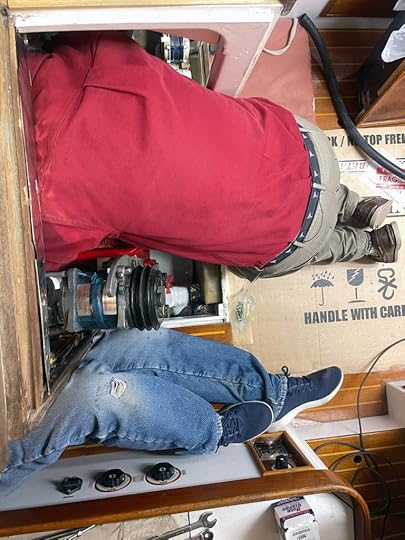
This summer, I’m sure that the new Beta will sound different than the old Perkins 4-108. But I’m equally sure that when the new engine is shut down, we’ll once again enjoy the familiar welcome of ahhhh-quiet—which will, purist contradictions aside, be well worth a winter’s worth of effort. So congratulations to Dad, and thank you Katrina for continuing to bring us all so much joy.
Got a boat project that’s taken more time than expected? Share your experience in the comments below, or send me an email. I read every single one, with gratitude. Meanwhile thanks for stopping by, and I’ll see you next week for a book review!
The post Repowering Katrina, and My Dad appeared first on Carol Newman Cronin.
May 15, 2025
Official Announcement: My Next Book
I must admit, I’ve been quite distracted the past few weeks. But one of the reasons is quite exciting: my sixth book will be out in the fall! Now that there’s a dedicated page on my website about The Heart of Hound: A Half Century of Sailing, Camaraderie, and Stewardship, it really feels like it’s going to happen.

The book is about a boat and her people. As most of you already know, I’ve been digging into the history of this 59-footer for a few years now—and, thanks to a team of editors and designers, the result will be a beautiful coffee-table book that pairs historic photos with her most memorable stories.
Hound is celebrating her 55th season with another ocean crossing, this time as part of the Transatlantic Race that starts June 18. I’ve been lucky enough to join the crew for a few practice sessions: yet another happy example of Where Books Meet Boats.
I can’t wait to share the team’s progress with all of you as the boat’s storyline sets sail across the pond once more. As I’ve been telling anyone who expresses even a mild interest: stop me when you’ve heard enough, because I could go on for hours!
If you want to learn more about the book, hop on over to The Heart of Hound page. For future updates, subscribe to this blog; for past stories, scroll down. And if you’re looking for more great photos like the one above, head on over to PaulCroninStudios. Meanwhile, thanks to each and every one of you for reading and commenting. Your enthusiasm definitely helps keep me blogging, even when life and Hound get in the way.
Previous Hound PostsThank You Letter to a Classic Sailboat
Hound in Sailing World: Running with the Pack
Choosing a Late Night Adventure
Gerhard Gilgenast: Curiosity Can Be Contagious
The Unique Joy of a Well-Designed Book
Primary Source Research: The Dusty Joyousness of Deep Dives
The post Official Announcement: My Next Book appeared first on Carol Newman Cronin.

